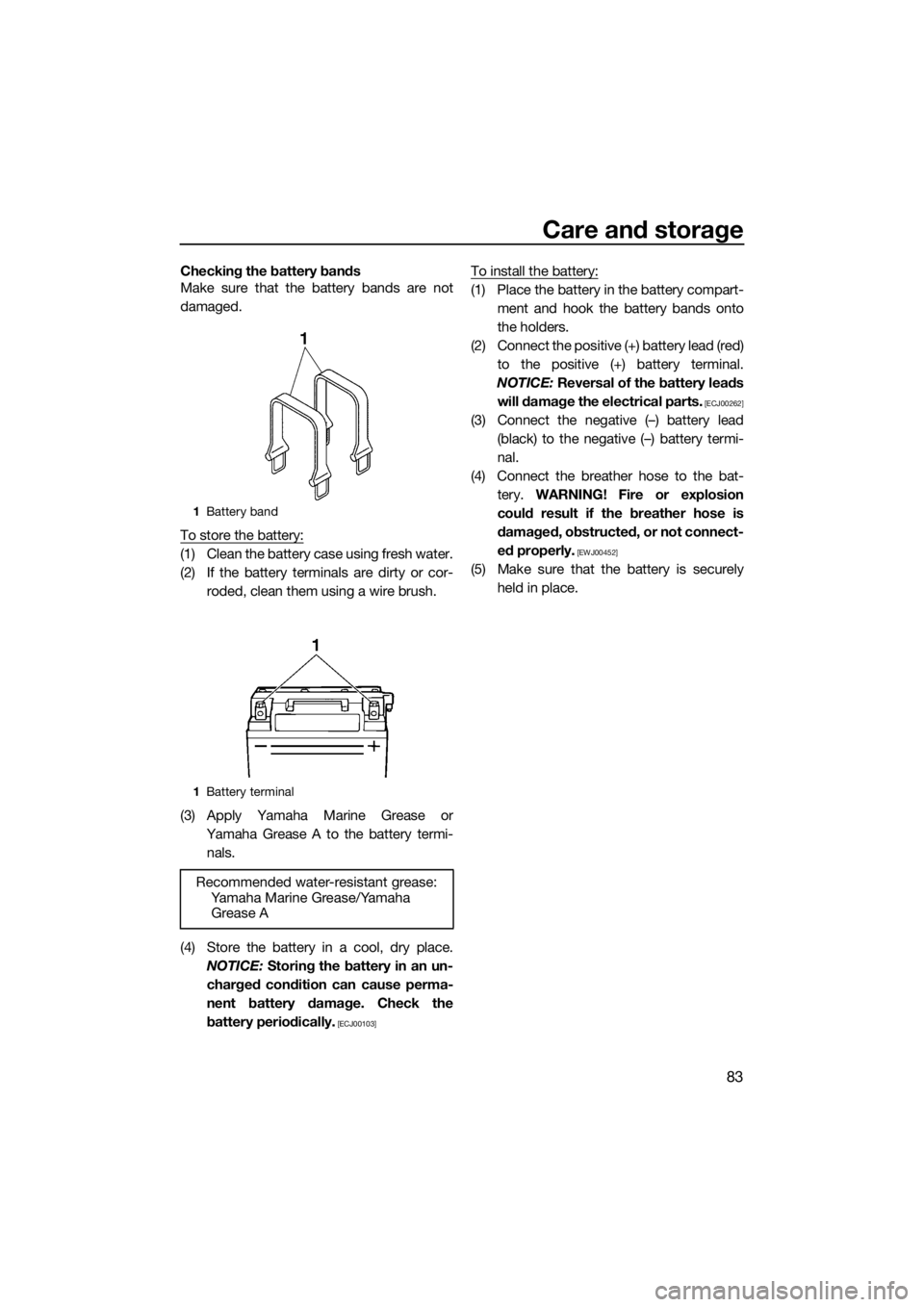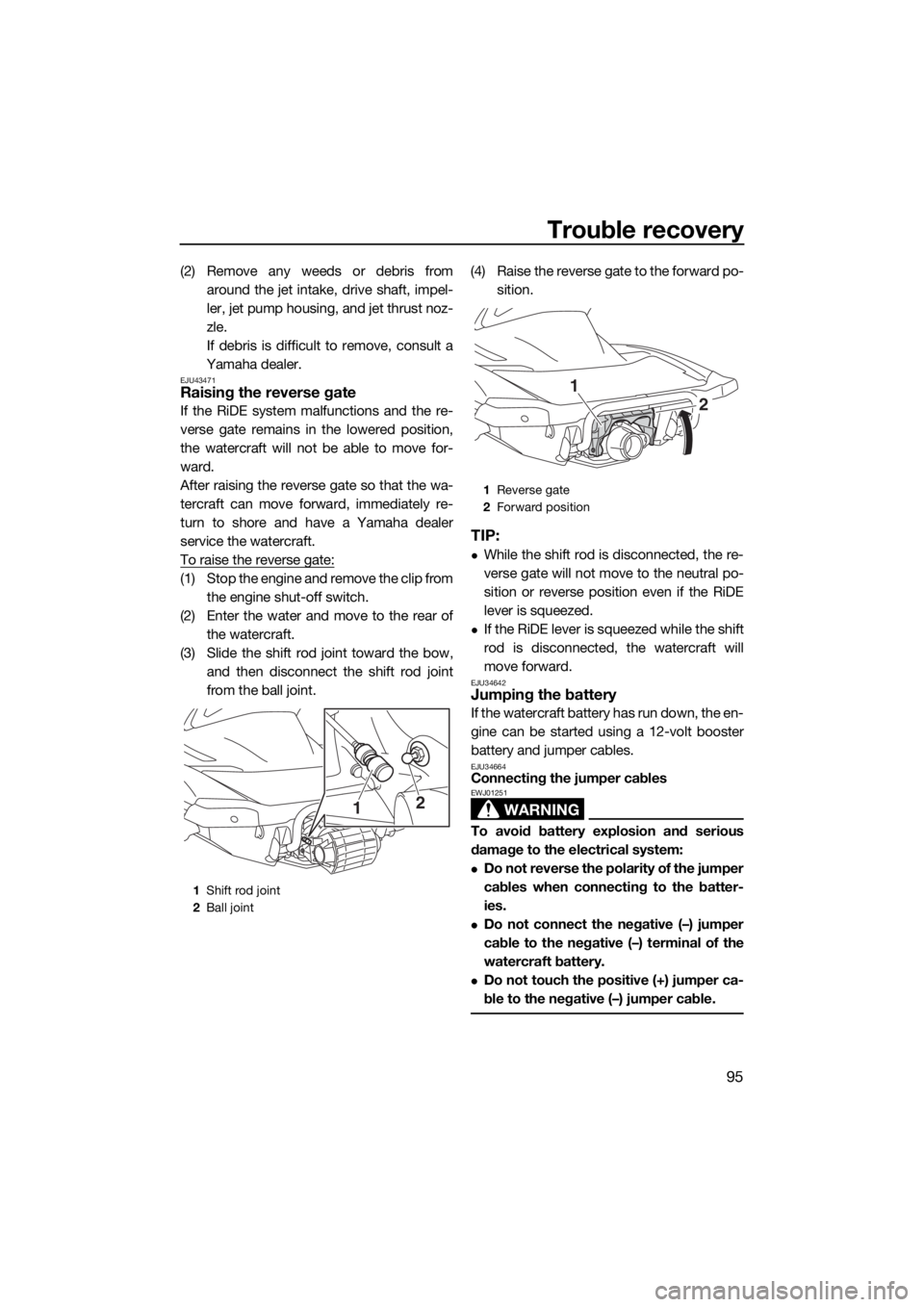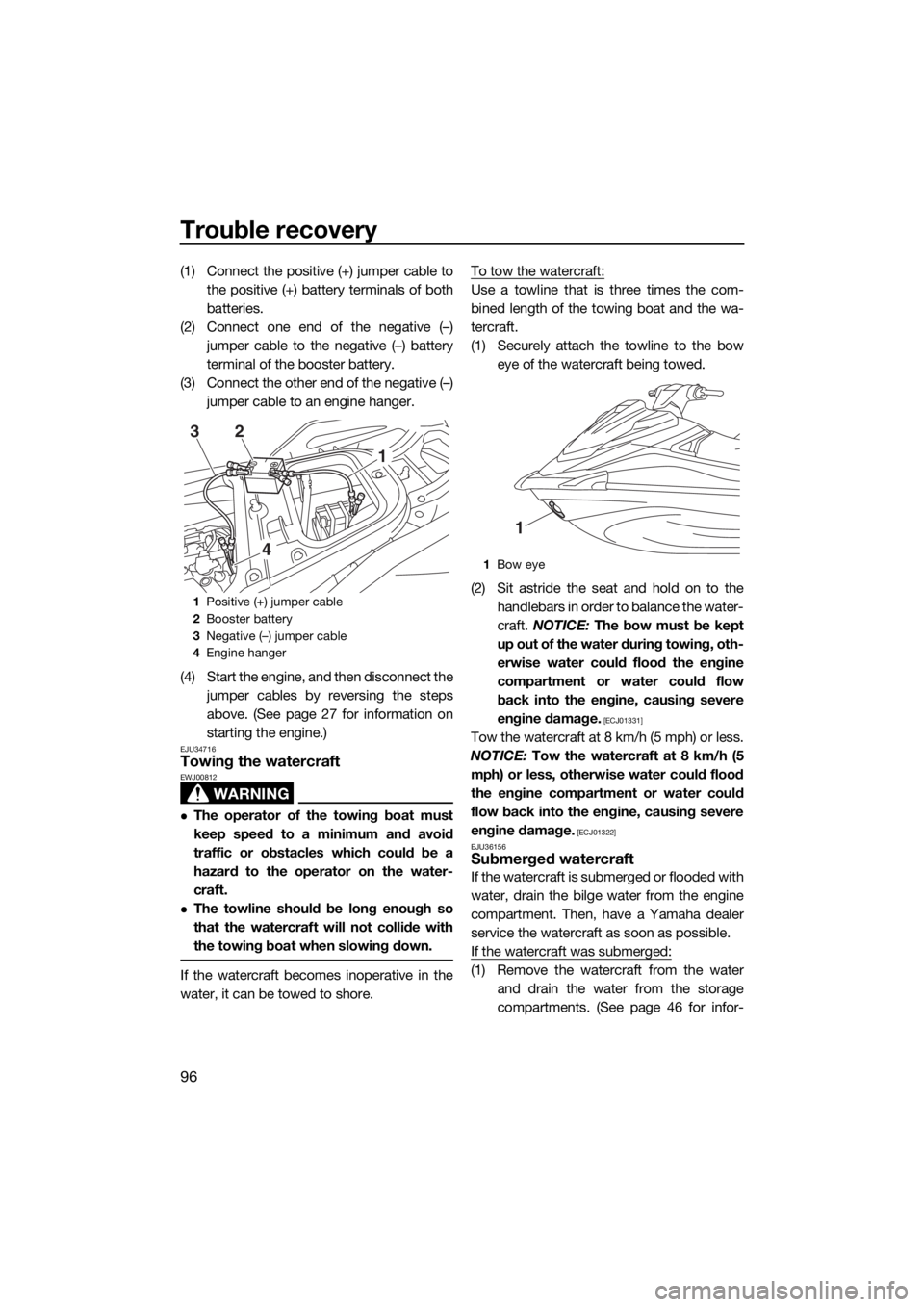battery YAMAHA VX CRUISER 2016 User Guide
[x] Cancel search | Manufacturer: YAMAHA, Model Year: 2016, Model line: VX CRUISER, Model: YAMAHA VX CRUISER 2016Pages: 108, PDF Size: 3.53 MB
Page 89 of 108

Care and storage
83
Checking the battery bands
Make sure that the battery bands are not
damaged.
To store the battery:
(1) Clean the battery case using fresh water.
(2) If the battery terminals are dirty or cor-
roded, clean them using a wire brush.
(3) Apply Yamaha Marine Grease or
Yamaha Grease A to the battery termi-
nals.
(4) Store the battery in a cool, dry place.
NOTICE: Storing the battery in an un-
charged condition can cause perma-
nent battery damage. Check the
battery periodically.
[ECJ00103]
To install the battery:
(1) Place the battery in the battery compart-
ment and hook the battery bands onto
the holders.
(2) Connect the positive (+) battery lead (red)
to the positive (+) battery terminal.
NOTICE: Reversal of the battery leads
will damage the electrical parts.
[ECJ00262]
(3) Connect the negative (–) battery lead
(black) to the negative (–) battery termi-
nal.
(4) Connect the breather hose to the bat-
tery. WARNING! Fire or explosion
could result if the breather hose is
damaged, obstructed, or not connect-
ed properly.
[EWJ00452]
(5) Make sure that the battery is securely
held in place.
1Battery band
1Battery terminal
Recommended water-resistant grease:
Yamaha Marine Grease/Yamaha
Grease A
UF4G70E0.book Page 83 Monday, September 28, 2015 3:14 PM
Page 93 of 108

Maintenance
87
EJU43101Periodic maintenance chart
The periodic maintenance chart gives general guidelines for periodic maintenance. Have a
Yamaha dealer perform the checks in the following chart. However, maintenance may need
to be performed more frequently depending on your operating conditions. If you have any
questions, consult a Yamaha dealer.
This “√” mark indicates items to be checked and serviced by a Yamaha dealer.
Item OperationInitial Thereafter every
Page
10 hours50 hours
or 12
months
*1100
hours or
12
months
*1200
hours or
24
months
*1
Fuel lineCheck fuel hoses and
clamps√—
Fuel filler cap/Wa-
ter separatorCheck O-rings for cracks
and deformation√—
Fuel tankCheck installation and
straps√—
Water inlet strainerCheck for clogs and dam-
age√—
Cooling water hos-
esCheck for damage and
leakage, and check
clamps√—
Engine oilReplace√√89
Oil filterReplace√89
Intermediate hous-
ingLubricate√—
Spark plugsCheck√√—
BatteryCheck state of charge,
terminals, bands, and
breather hose√—
Battery leadsCheck terminals√—
Steering masterCheck operation and for
looseness√√—
Steering cableCheck exterior and con-
nections, and lubricate√—
Shift rod and re-
verse gateCheck exterior and con-
nections, and lubricate√—
Air filter elementCheck for damage and
dirt√—
Air intake hosesCheck for damage, and
check clamps√—
Throttle bodyLubricate throttle valves√—
UF4G70E0.book Page 87 Monday, September 28, 2015 3:14 PM
Page 96 of 108

Specifications
90
EJU34543
Specifications
Watercraft capacity:
Maximum people on board:
3 person
Maximum load capacity:
240 kg (530 lb)
Dimensions and weight:
Length:
3340 mm (131.5 in) (VX)
3350 mm (131.9 in) (VX Deluxe / VX Cruiser /
VX Limited)
Width:
1220 mm (48.0 in)
Height:
1190 mm (46.9 in)
Dry weight:
321 kg (708 lb) (VX)
301 kg (664 lb) (VX Deluxe)
303 kg (668 lb) (VX Cruiser / VX Limited)
Performance:
Maximum output (according to ISO 8665/SAE
J1228):
84.6 kW at 8000 r/min
Maximum fuel consumption:
33.5 L/h (8.8 US gal/h, 7.4 Imp.gal/h)
Cruising range at full throttle:
2.09 hour
Trolling speed:
1500 ±100 r/min
Engine:
Engine type:
Liquid cooled 4-stroke, DOHC
Number of cylinders:
3
Engine displacement:
1049 cm³
Bore × stroke:
82.0 × 66.2 mm (3.23 × 2.61 in)
Compression ratio:
11.0 : 1
Valve clearance-intake (cold):
0.15–0.22 mm (0.0059–0.0087 in)
Valve clearance-exhaust (cold):
0.26–0.32 mm (0.0102–0.0126 in)
Lubrication system:
Dry sump
Cooling system:
WaterStarting system:
Electric
Ignition system:
T.C.I.
Spark plug (NGK):
CR9EB
Spark plug gap:
0.7–0.8 mm (0.028–0.031 in)
Battery capacity:
12 V, 19 Ah
Charging system:
Flywheel magneto
Drive unit:
Propulsion system:
Jet pump
Jet pump type:
Axial flow, single stage
Impeller rotation:
Counterclockwise
Jet thrust nozzle angle:
24+24 °
Fuel and oil:
Recommended fuel:
Regular unleaded gasoline
Minimum octane rating (PON):
86
Minimum octane rating (RON):
90
Recommended engine oil:
YAMALUBE 4W or 4-stroke motor oil
Recommended engine oil type SAE:
SAE 10W-30, 10W-40, 20W-40, 20W-50
Recommended engine oil grade API:
API SE,SF,SG,SH,SJ,SL
Fuel tank total capacity:
70 L (18.5 US gal, 15.4 Imp.gal)
Engine oil quantity with oil filter replacement:
3.4 L (3.59 US qt, 2.99 Imp.qt)
Engine oil quantity without oil filter replacement:
3.2 L (3.38 US qt, 2.82 Imp.qt)
Engine oil total quantity:
3.7 L (3.91 US qt, 3.26 Imp.qt)
UF4G70E0.book Page 90 Monday, September 28, 2015 3:14 PM
Page 97 of 108

Trouble recovery
91
EJU34562
Troubleshooting
If you have any trouble with your watercraft, use the troubleshooting chart to check for the
possible cause.
If you cannot find the cause, consult a Yamaha dealer.
EJU44120Troubleshooting chart
Confirm the possible cause and remedy, and then refer to the applicable page.
TROUBLE POSSIBLE CAUSE REMEDY PAGE
Engine does not
start (Starter motor
does not turn over)Ya m a h a S e -
curity System
(VX Deluxe /
VX Cruiser /
VX Limited)Lock mode selected Select unlock mode
26
Engine shut-
off switchClip not in place Install clip
27
Fuse Burned out Have serviced by
Yamaha dealer—
Battery Run down Recharge 81
Poor terminal con-
nectionsTighten as required
81
Terminal corroded Clean or replace 81
Starter motor Faulty Have serviced by
Yamaha dealer—
Engine does not
start (Starter motor
turns over)Throttle lever Squeezed Release 27
Faulty Have serviced by
Yamaha dealer—
RiDE lever Squeezed Release 27
Faulty Have serviced by
Yamaha dealer—
Fuel Fuel tank empty Refill as soon as pos-
sible50
Stale or contaminat-
edHave serviced by
Yamaha dealer—
Fuel tank Water or dirt present Have serviced by
Yamaha dealer—
Spark plug Fouled or defective Have serviced by
Yamaha dealer—
Fuel injec-
tion systemFuel pump faulty Have serviced by
Yamaha dealer—
UF4G70E0.book Page 91 Monday, September 28, 2015 3:14 PM
Page 101 of 108

Trouble recovery
95
(2) Remove any weeds or debris from
around the jet intake, drive shaft, impel-
ler, jet pump housing, and jet thrust noz-
zle.
If debris is difficult to remove, consult a
Yamaha dealer.
EJU43471Raising the reverse gate
If the RiDE system malfunctions and the re-
verse gate remains in the lowered position,
the watercraft will not be able to move for-
ward.
After raising the reverse gate so that the wa-
tercraft can move forward, immediately re-
turn to shore and have a Yamaha dealer
service the watercraft.
To raise the reverse gate:
(1) Stop the engine and remove the clip from
the engine shut-off switch.
(2) Enter the water and move to the rear of
the watercraft.
(3) Slide the shift rod joint toward the bow,
and then disconnect the shift rod joint
from the ball joint.(4) Raise the reverse gate to the forward po-
sition.
TIP:
While the shift rod is disconnected, the re-
verse gate will not move to the neutral po-
sition or reverse position even if the RiDE
lever is squeezed.
If the RiDE lever is squeezed while the shift
rod is disconnected, the watercraft will
move forward.
EJU34642Jumping the battery
If the watercraft battery has run down, the en-
gine can be started using a 12-volt booster
battery and jumper cables.
EJU34664Connecting the jumper cables
WARNING
EWJ01251
To avoid battery explosion and serious
damage to the electrical system:
Do not reverse the polarity of the jumper
cables when connecting to the batter-
ies.
Do not connect the negative (–) jumper
cable to the negative (–) terminal of the
watercraft battery.
Do not touch the positive (+) jumper ca-
ble to the negative (–) jumper cable.
1Shift rod joint
2Ball joint
12
1Reverse gate
2Forward position
1
2
UF4G70E0.book Page 95 Monday, September 28, 2015 3:14 PM
Page 102 of 108

Trouble recovery
96
(1) Connect the positive (+) jumper cable to
the positive (+) battery terminals of both
batteries.
(2) Connect one end of the negative (–)
jumper cable to the negative (–) battery
terminal of the booster battery.
(3) Connect the other end of the negative (–)
jumper cable to an engine hanger.
(4) Start the engine, and then disconnect the
jumper cables by reversing the steps
above. (See page 27 for information on
starting the engine.)
EJU34716Towing the watercraft
WARNING
EWJ00812
The operator of the towing boat must
keep speed to a minimum and avoid
traffic or obstacles which could be a
hazard to the operator on the water-
craft.
The towline should be long enough so
that the watercraft will not collide with
the towing boat when slowing down.
If the watercraft becomes inoperative in the
water, it can be towed to shore.To tow the watercraft:
Use a towline that is three times the com-
bined length of the towing boat and the wa-
tercraft.
(1) Securely attach the towline to the bow
eye of the watercraft being towed.
(2) Sit astride the seat and hold on to the
handlebars in order to balance the water-
craft. NOTICE: The bow must be kept
up out of the water during towing, oth-
erwise water could flood the engine
compartment or water could flow
back into the engine, causing severe
engine damage.
[ECJ01331]
Tow the watercraft at 8 km/h (5 mph) or less.
NOTICE: Tow the watercraft at 8 km/h (5
mph) or less, otherwise water could flood
the engine compartment or water could
flow back into the engine, causing severe
engine damage.
[ECJ01322]
EJU36156
Submerged watercraft
If the watercraft is submerged or flooded with
water, drain the bilge water from the engine
compartment. Then, have a Yamaha dealer
service the watercraft as soon as possible.
If the watercraft was submerged:
(1) Remove the watercraft from the water
and drain the water from the storage
compartments. (See page 46 for infor-
1Positive (+) jumper cable
2Booster battery
3Negative (–) jumper cable
4Engine hanger
1
23
41Bow eye
1
UF4G70E0.book Page 96 Monday, September 28, 2015 3:14 PM
Page 104 of 108

98
Index
A
After removing the watercraft from the
water ..................................................... 79
B
Battery care.............................................. 81
Battery checks ......................................... 60
Battery, jumping ....................................... 95
Beaching and docking the watercraft ...... 78
Bilge water check..................................... 60
Bilge water, draining ................................ 54
Bilge water, draining on land ................... 54
Bilge water, draining on water ................. 54
Boarding alone ......................................... 74
Boarding and starting off from a dock ..... 77
Boarding the watercraft ........................... 74
Boarding with passenger(s) ..................... 75
Bow eye ................................................... 45
Bow storage compartment ...................... 46
Builder’s plate ............................................ 2
C
Capsized watercraft ................................. 77
Check engine warning ............................. 41
Cleaning ................................................... 84
Cleaning the watercraft ............................ 81
Cleat ......................................................... 45
Cooling water pilot outlet ......................... 29
Cooling water pilot outlet check .............. 65
Craft Identification Number (CIN)............... 1
Cruise assist
(VX Deluxe / VX Cruiser / VX Limited) ... 36
Cruising limitations................................... 11
E
Emergency procedures ............................ 94
Engine break-in ........................................ 56
Engine compartment check ..................... 59
Engine idling speed check ....................... 66
Engine oil ................................................. 52
Engine oil and oil filter .............................. 89
Engine oil level check............................... 60
Engine oil requirements ........................... 52
Engine overheat warning ......................... 41
Engine serial number ................................. 1
Engine shut-off cord (lanyard) check ....... 62
Engine shut-off switch ............................. 27
Engine stop switch................................... 27Engine unit check ..................................... 60
Enjoy your watercraft responsibly ............ 19
Equipment ................................................ 43
F
Fire extinguisher check ............................ 64
Fire extinguisher holder and cover........... 48
Fire extinguisher holder, cover, and
band checks ......................................... 63
Flushing the cooling water passages....... 80
Fuel .......................................................... 50
Fuel level check........................................ 59
Fuel level meter ........................................ 40
Fuel level warning..................................... 40
Fuel requirements .................................... 50
Fuel system checks ................................. 59
G
Getting to know your watercraft .............. 68
Glossary, watercraft ................................. 20
Glove compartment ................................. 47
H
Handgrip .................................................. 44
Hazard information................................... 15
Hood check .............................................. 65
Hour meter ............................................... 42
Hull and deck check ................................ 64
I
Identification numbers ............................... 1
Information display................................... 38
J
Jet intake and impeller, cleaning.............. 94
Jet intake checks ..................................... 64
Jet thrust nozzle and reverse gate
check .................................................... 64
Jumper cables, connecting ...................... 95
L
Labels, important ....................................... 4
Labels, other .............................................. 8
Labels, warning .......................................... 5
Launching the watercraft ......................... 69
Learning to operate your watercraft......... 68
Leaving the watercraft.............................. 70
Limitations on who may operate the
watercraft .............................................. 10
Long-term storage ................................... 84
UF4G70E0.book Page 98 Monday, September 28, 2015 3:14 PM